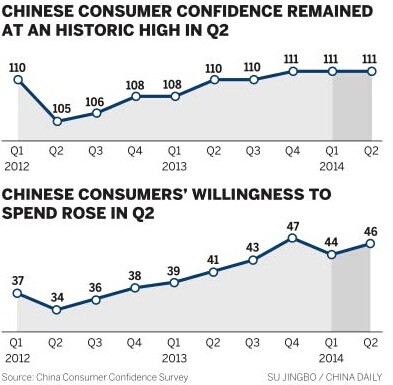

Nielsen index maintains high level in Q2 as inflation gauge declines
Chinese consumer confidence remained high in the second quarter, thanks to average wage increases and a reduced consumer price index, Nielsen said on Monday.
The consulting firm said the confidence index stood at 111, marking the third consecutive quarter at this level and one point higher than a year earlier.
China's GDP growth also edged up in the second quarter to 7.5 percent from a year earlier, slightly higher than the first quarter's 7.4 percent, data from the National Bureau of Statistics showed on Wednesday. And HSBC Holdings Plc on Monday upgraded its forecast for the country's economic growth to 7.5 percent from 7.4 percent, saying recovery has been stronger than expected.
The economic expansion in the second quarter "surprised on the upside relative to our forecast" owing to stronger-than-expected government support measures, HSBC Chief China Economist Qu Hongbin said in a report released Monday.
The improved economic forecast for China, the US and parts of Europe will help boost consumers' confidence, but the direct driver is higher disposable income and a reasonable consumer price index, according to Patrick Dodd, managing director of Nielsen China.
"During China's ongoing transformation from an investment-to consumption-driven economy, per capita spending continues to grow due to increasing disposable income," Dodd said.
In the second quarter of 2014, Chinese consumers' willingness to spend reached 46 percent, 2 percentage points higher than in the previous quarter, according to Nielsen's findings. Meanwhile, their perceptions about personal finance increased one percentage point to 70 percent.
Last year saw a 14 percent jump in average pay for China's 269 million migrant workers, making it possible for them to spend more, said Dodd.
"These consumers share the same pursuits for a better and higher quality life as the existing middle class, and they will put their increasing disposable income to work to achieve these dreams," Dodd added.
Meanwhile, the CPI, the main gauge of inflation, moderated to 2.3 percent growth in June, down from 2.5 percent in May, NBS statistics showed.
Consumers in third-tier cities reported the highest confidence index of 113 points, closely followed by fourth-tier cities at 112 points. First- and second-tier cities shared a confidence level of 110 points. Confidence in rural areas was unchanged from the previous quarter, at 110 points, according to Nielsen.
"Deepening urbanization is another key driver behind China's high level of confidence. Even though more than half of China's 1.35 billion people live in towns and cities, the urbanization rate in China, compared with that of the US and the EU, is still low, meaning millions of new consumers with cash to spend will emerge in the coming decade," said Dodd.
Despite overall retail sales growth of 12.4 percent in the first half of this year, compared with the same period last year, the growth of offline fast-moving consumer goods retail sales as measured by Nielsen slowed from 7.5 percent in the first quarter to 5.4 percent in the second quarter.
"This is due in part to a growing migration of Chinese consumers from offline to online," said Dodd.
For the 11 categories audited both online and offline, online sales increased from 15.2 percent of total sales in May of last year to 19.6 percent in May this year. Offline sales still account for the majority of all sales, occupying around 80 percent.
Nielsen research also showed that online sales, with 6.8 percent, contributed more to the overall growth rate of 12.7 percent in these 11 categories, compared with only 5.9 percent from offline sales.
Consumer confidence sags in May
2014-06-10Consumer confidence remains at record level in Q1: Nielsen
2014-05-28Consumer confidence climbs 3 points in Q1
2014-05-28Consumer confidence stabilizes in May, report says
2014-05-22China‘s bank card consumer confidence picks up
2014-05-11China‘s bankcard consumer confidence rebounds in March
2014-04-12Copyright ©1999-2018
Chinanews.com. All rights reserved.
Reproduction in whole or in part without permission is prohibited.